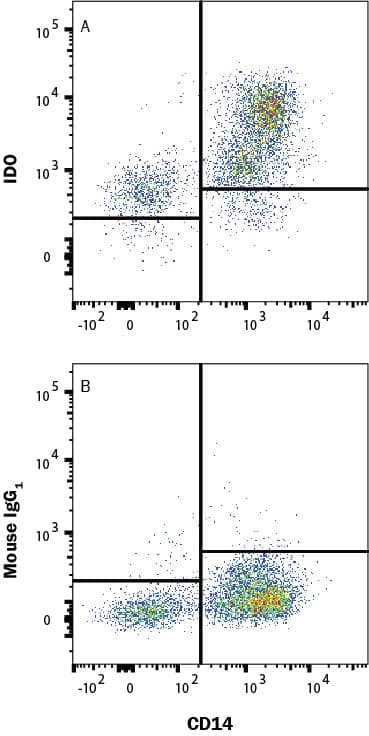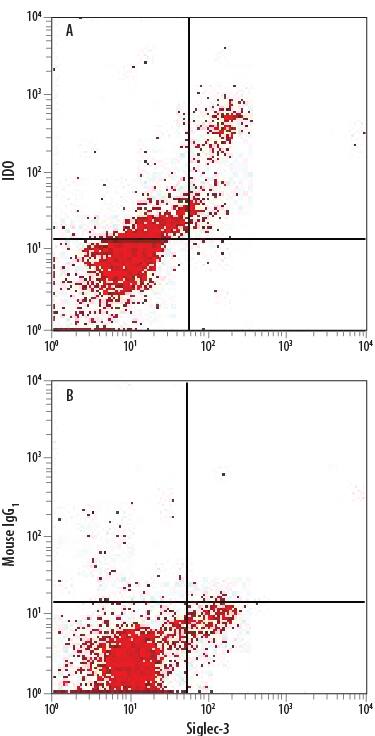Human Indoleamine 2,3-dioxygenase/IDO APC-conjugated Antibody
R&D Systems, part of Bio-Techne | Catalog # IC6030A


Conjugate
Catalog #
Key Product Details
Validated by
Biological Validation
Species Reactivity
Validated:
Human
Cited:
Human
Applications
Validated:
Intracellular Staining by Flow Cytometry
Cited:
Flow Cytometry
Label
Allophycocyanin (Excitation = 620-650 nm, Emission = 660-670 nm)
Antibody Source
Monoclonal Mouse IgG1 Clone # 700838
Product Specifications
Immunogen
E. coli-derived recombinant human Indoleamine 2,3-dioxygenase/IDO
Ala2-Gly403
Accession # P14902
Ala2-Gly403
Accession # P14902
Specificity
Detects human Indoleamine 2,3-dioxygenase/IDO in direct ELISA.
Clonality
Monoclonal
Host
Mouse
Isotype
IgG1
Scientific Data Images for Human Indoleamine 2,3-dioxygenase/IDO APC-conjugated Antibody
Detection of Indoleamine 2,3‑dioxygenase/IDO in Human Monocytes by Flow Cytometry.
Human Monocytes were selected from PBMC using MagCellect Human CD14+ Cell Isolation Kit (MAGH105) and cultured overnight with Recombinant Human MCSF (50 ng/mL; 216-MC), Recombinant Human IFN gamma (50 ng/mL; 285-IF) and 50 ng/mL LPS and stained with (A) Mouse Anti-Human Indoleamine 2,3-dioxygenase/IDO APC-conjugated Monoclonal Antibody (Catalog # IC6030A) or (B) Mouse IgG1 isotype control antibody (IC002A) and Mouse Anti-Human CD14 PE-conjugated Monoclonal Antibody (FAB3832P). To facilitate intracellular staining, cells were fixed and permeabilized with FlowX FoxP3/Transcription Factor Fixation & Perm Kit (FC012). Staining was performed using our Staining Intracellular Molecules protocol.Detection of Indoleamine 2,3‑dioxygenase/IDO in Human MDSCs by Flow Cytometry.
Human PBMC-derived myeloid-derived suppressor cells (MDSCs) treated with 10 ng/mL Recombinant Human IL-6 (Catalog # 206-IL) and 10 ng/mL Recombinant Human GM-CSF (Catalog # 215-GM) for 7 days were stained with Mouse Anti-Human Siglec-3/CD33 PE-conjugated Monoclonal Antibody (Catalog # FAB1137P) and either (A) Mouse Anti-Human Indoleamine 2,3-dioxygenase/IDO APC-conjugated Monoclonal Antibody (Catalog # IC6030A) or (B) Mouse IgG1Allophycocyanin Isotype Control (Catalog # IC002A). To facilitate intracellular staining, cells were fixed with Flow Cytometry Fixation Buffer (Catalog # FC004) and permeabilized with Flow Cytometry Permeabilization/Wash Buffer I (Catalog # FC005). View our protocol for Staining Intracellular Molecules.Applications for Human Indoleamine 2,3-dioxygenase/IDO APC-conjugated Antibody
Application
Recommended Usage
Intracellular Staining by Flow Cytometry
10 µL/106 cells
Sample: Human myeloid-derived suppressor cells (MDSCs) treated with Recombinant Human IL‑6 (Catalog # 206-IL) and Recombinant Human GM‑CSF (Catalog # 215-GM) were fixed with Flow Cytometry Fixation Buffer (Catalog # FC004) and permeabilized with Flow Cytometry Permeabilization/Wash Buffer I (Catalog # FC005) and Human Monocytes selected from PBMC using MagCellect Human CD14+ Cell Isolation Kit (Catalog # MAGH105) and cultured overnight with Recombinant Human MCSF (50 ng/mL, Catalog # 216-MC), Recombinant Human IFN gamma (50 ng/mL, Catalog # 285-IF) and 50 ng/mL LPS
Sample: Human myeloid-derived suppressor cells (MDSCs) treated with Recombinant Human IL‑6 (Catalog # 206-IL) and Recombinant Human GM‑CSF (Catalog # 215-GM) were fixed with Flow Cytometry Fixation Buffer (Catalog # FC004) and permeabilized with Flow Cytometry Permeabilization/Wash Buffer I (Catalog # FC005) and Human Monocytes selected from PBMC using MagCellect Human CD14+ Cell Isolation Kit (Catalog # MAGH105) and cultured overnight with Recombinant Human MCSF (50 ng/mL, Catalog # 216-MC), Recombinant Human IFN gamma (50 ng/mL, Catalog # 285-IF) and 50 ng/mL LPS
Formulation, Preparation, and Storage
Purification
Protein A or G purified from hybridoma culture supernatant
Formulation
Supplied in a saline solution containing BSA and Sodium Azide.
Shipping
The product is shipped with polar packs. Upon receipt, store it immediately at the temperature recommended below.
Stability & Storage
Protect from light. Do not freeze.
- 12 months from date of receipt, 2 to 8 °C as supplied.
Background: Indoleamine 2,3-dioxygenase/IDO
References
- Lewis-Ballester, A. et al. (2009) Proc. Natl. Acad. Sci. USA. 106:17371.
- Costantino, G. (2009) Expert Opin. Ther. Targets 13:247.
- Xu, H. et al. (2008) Immunol. Lett. 121:1.
- Lob, S. et al. (2009) Nat. Rev. Cancer 9:445.
- Curti, A. et al. (2009) Blood 113:2394.
Alternate Names
3dioxygenase, IDO, IDO1, INDO, Indoleamine 2
Gene Symbol
IDO1
UniProt
Additional Indoleamine 2,3-dioxygenase/IDO Products
Product Documents for Human Indoleamine 2,3-dioxygenase/IDO APC-conjugated Antibody
Product Specific Notices for Human Indoleamine 2,3-dioxygenase/IDO APC-conjugated Antibody
For research use only
